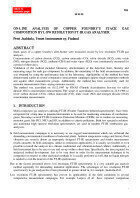Air monitoring
ON-LINE ANALYSIS OF COPPER FOUNDRY’S STACK GAS COMPOSITION BY LOW RESOLUTION FT-IR GAS ANALYSER
Oct 06 2014
Author: Petri Jaakkola on behalf of CEM
ABSTRACT
Stack gases of a copper foundry's after-burner were measured on-site by low resolution FT-IR gas analyser.
Concentrations of carbon dioxide (CO2), carbon monoxide (CO), sulfur dioxide (SO2), nitric oxide (NO), nitrogen dioxide (NO2), methane (CH4) and water vapor (H2O) were continuously measured for a period of three days.
Validation of the method included laboratory determination of the detection limit, linearity and measuring range for each gas component. In addition, the uncertainty of the field measurement results was obtained by using the performance data in the laboratory. Applicability of the method has been demonstrated earlier in several comparative measurement campaigns against single component methods and against other measurement groups. Additionally, the method has been successfully used for emission measurements from varying emission sources.
The method was accredited on 10.12.1997 by FINAS (Finnish Accreditation Service) for sulfur dioxide (SO2) concentration measurement. The scope of accreditation was extended on 24.9.1998 to cover carbon dioxide (CO2), carbon monoxide (CO), nitric oxide (NO) and nitrogen dioxide (NO2) concentration measurements.
1. INTRODUCTION
Multi-component gas analysers utilizing FT-IR (Fourier Transform Infrared)-spectrometry have been recognized for a long time as potential instruments to be used for monitoring emissions of combustion gases. Nowadays several FT-IR Continuous Emissions Monitors (CEMs) are in routine use measuring emission gases like HCl, NH3 and HF, in addition to criteria pollutants. Both low spectral resolution and traditional high spectral resolution spectrometers are used in modern FT-IR combustion gas analysers.
In field measurement campaigns it is necessary to use rugged instrumentation which can withstand the demanding environmental conditions of industrial plants. Ambient temperature swings and factory floor vibration can severely distort an improperly designed FT-IR spectrometer and render measurement results unusable. In field campaigns, unlike in continuous applications, it is usually not feasible or even possible to install the analyser in a climate conditioned and vibration-isolated cabinet. Additionally, a field instrument has to be easy to use and set-up within a short time. Specifically, the time required for analytical method development has to be very short in order for the measurement technique to be competitive in respect to other analytical methods. It is usually preferred as well, that no liquid nitrogen is needed to cool the detector of the FT-IR spectrometer.
Due to the factors presented above, low resolution FT-IR spectrometry is a very suitable gas analysis method especially for demanding industrial applications. The advantages of low resolution FT-IR spectrometry in gas analysis have been presented in greater detail in, for example, Jaakkola et al.
Low resolution FT-IR spectrometry has proven its applicability in the field conditions in several comparative measurement campaigns. For example Larjava et al. have reported comparison measurements performed with low resolution FT-IR gas analyser against several single component analysers.
Digital Edition
IET 35.2 March
April 2025
Air Monitoring - Probe Sampling in Hazardous Areas Under Extreme Conditions - New, Game-Changing Sensor for Methane Emissions - Blue Sky Thinking: a 50-year Retrospective on Technological Prog...
View all digital editions
Events
Jun 04 2025 Koeln, Germany
Jun 04 2025 Shanghai, China
Jun 08 2025 Denver, CO, USA
Jun 09 2025 Raleigh, NC, USA
Jun 10 2025 Toulouse, France





.jpg)









